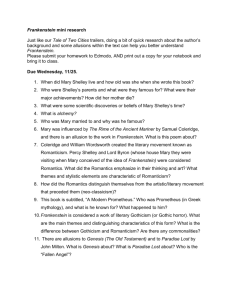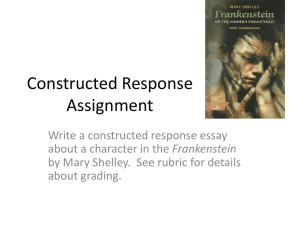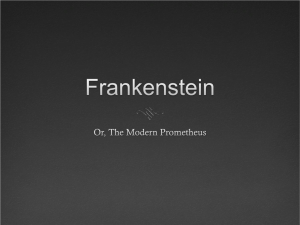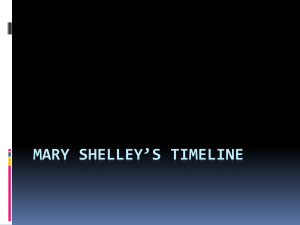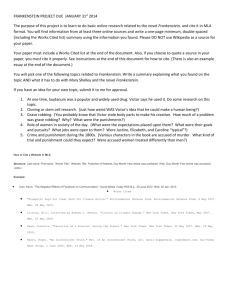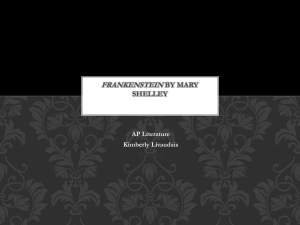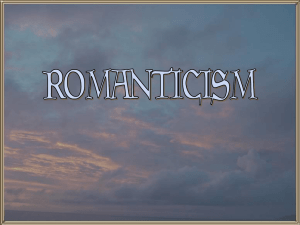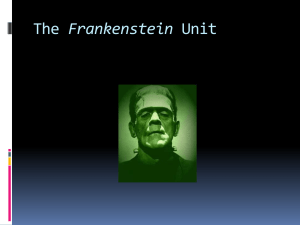What students don*t know about research
advertisement
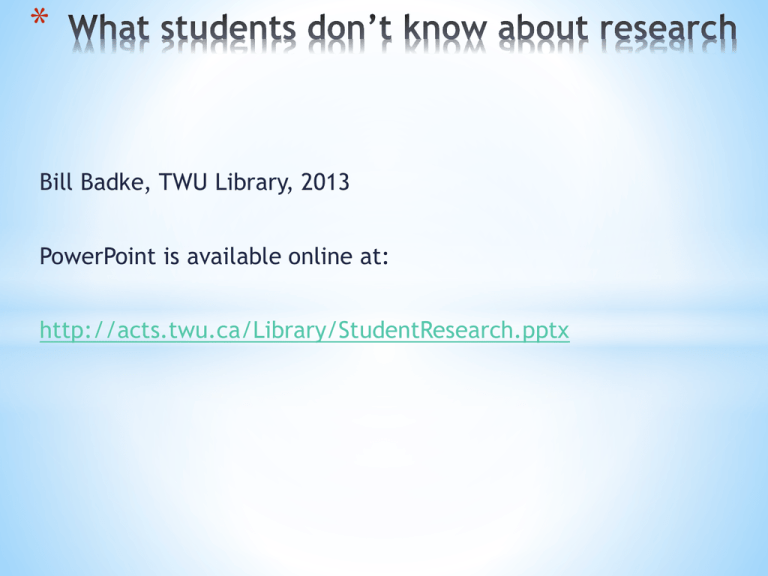
* Bill Badke, TWU Library, 2013 PowerPoint is available online at: http://acts.twu.ca/Library/StudentResearch.pptx * Today’s students have grown up with Google, the information candy store: * Today’s students have grown up with Google, the information candy store: Search is easy * Today’s students have grown up with Google, the information candy store: Search is easy Results are numerous * Today’s students have grown up with Google, the information candy store: Search is easy Results are numerous Good enough is good enough * Today’s students have grown up with Google, the information candy store: Search is easy Results are numerous Good enough is good enough Academic information – What’s that? * Today’s students have grown up with Google, the information candy store: Search is easy Results are numerous Good enough is good enough Academic information – What’s that? Professors hate Wikipedia for some reason * Today’s students have grown up with Google, the information candy store: Search is easy Results are numerous Good enough is good enough Academic information – What’s that? Professors hate Wikipedia for some reason The library is clunky and hard to use. We have Google. * But the problem is deeper than just a fixation on Google. Our students often lack an understanding of context. * Keyword searching is “flat.” It does not recognize the hierarchical nature of information – that every bit of information is part of some broader context: * Students also come from a tradition of research as compilation. * Here is the distinction we need to make: “Finding out about a topic” is not research. This approach treats the discovery of existing information as its goal. Genuine research demands some sort of problem-solving, that is, critical analysis leading to a conclusion. Information is thus a tool rather than a goal. The true goal of research is to advance beyond existing information. * It is a recipe for research disaster for students to assume that no distinct research goal is required. This assumption leads to broad surveys, lack of critical thinking, and a lot of student anxiety. Anxiety? Why anxiety? Because not knowing where you are going assumes that you won’t know how to get there. A little planning can work wonders. * While seasoned academics can come at a research project from any number of directions and can work in quite a non-linear manner, novice researchers need a much more linear and structured process. This entails: Gaining a working knowledge of the topic Developing a research question that is focused and problem-solving in orientation Gathering information – books, journals, etc. Evaluating gathered information for quality and relevance Organizing gathered information to answer the research question Writing * A working knowledge can be basic and is best obtained through reference sources. The library has many dictionaries and encyclopedias in print and electronic form (for the latter, see http://acts.twu.ca/Library/ReferenceEBooksTWULibrary.pdf ). * Research questions are more challenging. Students must be able to conceptualize what is required in a research project, though they may, developmentally, be struggling to acquire critical thinking capacity. Their limited facility with seeing information in context may prevent them from being able to conceptualize a research problem. * It is crucial to enable students to submit research questions for professorial evaluation and revision before they are allowed to go on to the other steps in research. A bad research question leads to a bad research paper. Return submitted student research questions for revision until they are right. * How might a student go wrong in a research question? 1.Formulating a question that calls just for compilation of existing information (information as goal rather than as tool). e.g. What are researchers saying about potential cancer risks from cell phone use? What did Mary Shelley in Frankenstein say about the role of women? * How might a student go wrong in a research question? 2. Creating a question that is too broad to lead to anything other than a survey. e.g. What has been happening in cell phone risk research over the past twenty years? What was the role of women in Mary Shelley’s time? * How might a student go wrong in a research question? 3. Creating a multipart question. e.g. What has been happening in cell phone risk research over the past twenty years and how have cell phone manufacturers tried to fix the problems and should we still use cell phones? What was the role of women in Mary Shelley’s time and how did that change in the century following her writing? * How might a student go wrong in a research question? 4. Creating a question that is open to many possible answers. e.g. What are the effects of cell phone use? How has Mary Shelley’s Frankenstein influenced society since her time? * What are the characteristics of a good research question? It is constructed narrowly, considering only an aspect of the larger topic. It demands analysis/evaluation that resolves a problem or issue and thus goes beyond what can easily be discovered. It is singular, not multiple. It is clear, not vague. You should be able to visualize the goal. It is capable of being answered with information and analysis It does not reach beyond what can be known. * Examples (from Duncan Dixon for Writing 100): Topic: Cell phone use and cancer Research Question: Considering the available research on microwaves and brain cancer, what is a prudent course for parents to take regarding cell phone use for their adolescent and preadolescent children? Topic: Frankenstein and Feminism Research Question: How might Mary Shelley have portrayed women in Frankenstein if she had been writing for a 21st Century audience? * Let’s break these down a bit: Topic: Cell phone use and cancer Research Question: Considering the available research on microwaves and brain cancer, what is a prudent course for parents to take regarding cell phone use for their adolescent and preadolescent children? This question does demand that the student gather information on available research regarding microwave risks from cell phones. But it goes on to present a problem needing a solution: “what is a prudent course for parents to take?” * Examples (from Duncan Dixon for Writing 100): Topic: Frankenstein and Feminism Research Question: How might Mary Shelley have portrayed women in Frankenstein if she had been writing for a 21st Century audience? The student must gather information on Mary Shelley’s portrayal of women in Frankenstein, but the question goes beyond in asking how she might have done this to a 21st century audience. * It is then helpful for students to map out a plan for their research using a preliminary outline drawn from the question: * It is then helpful for students to map out a plan for their research using a preliminary outline drawn from the question:

